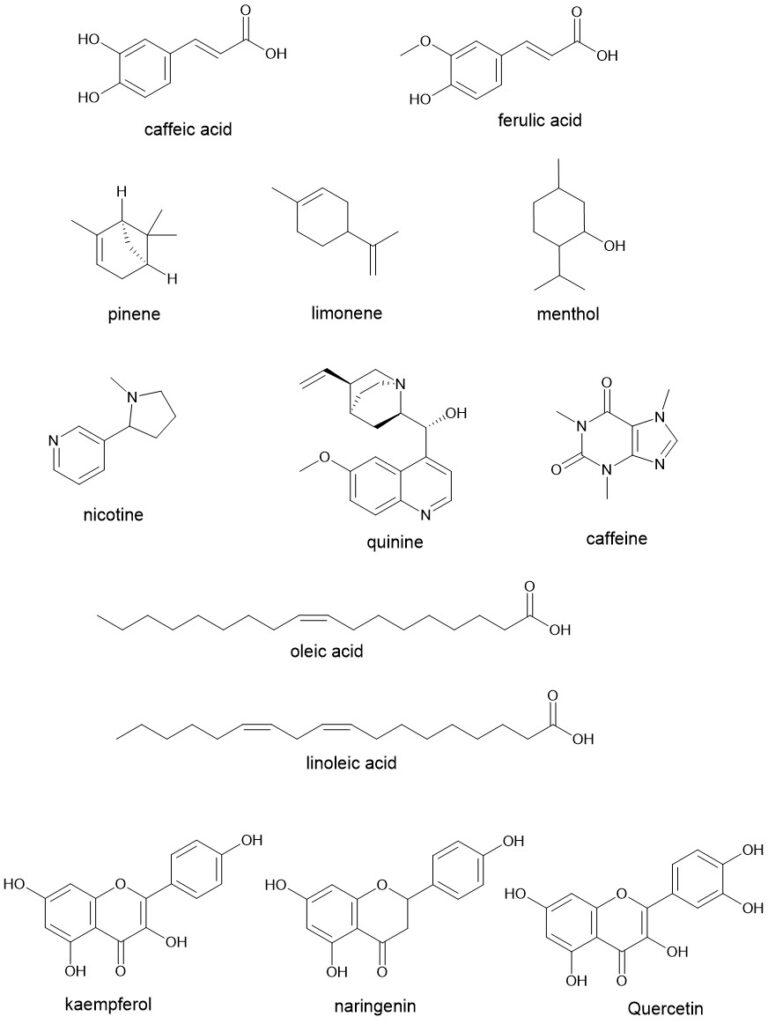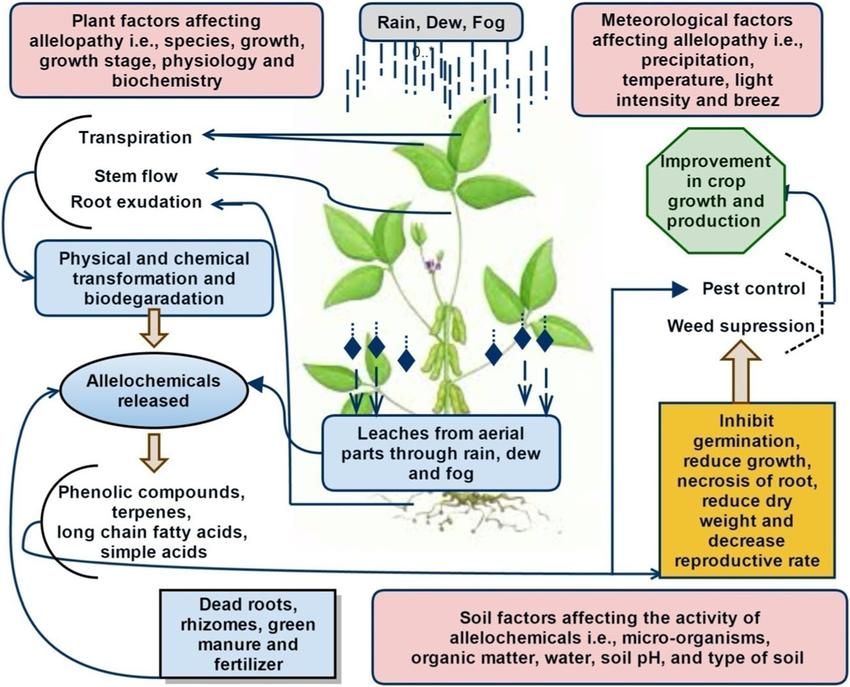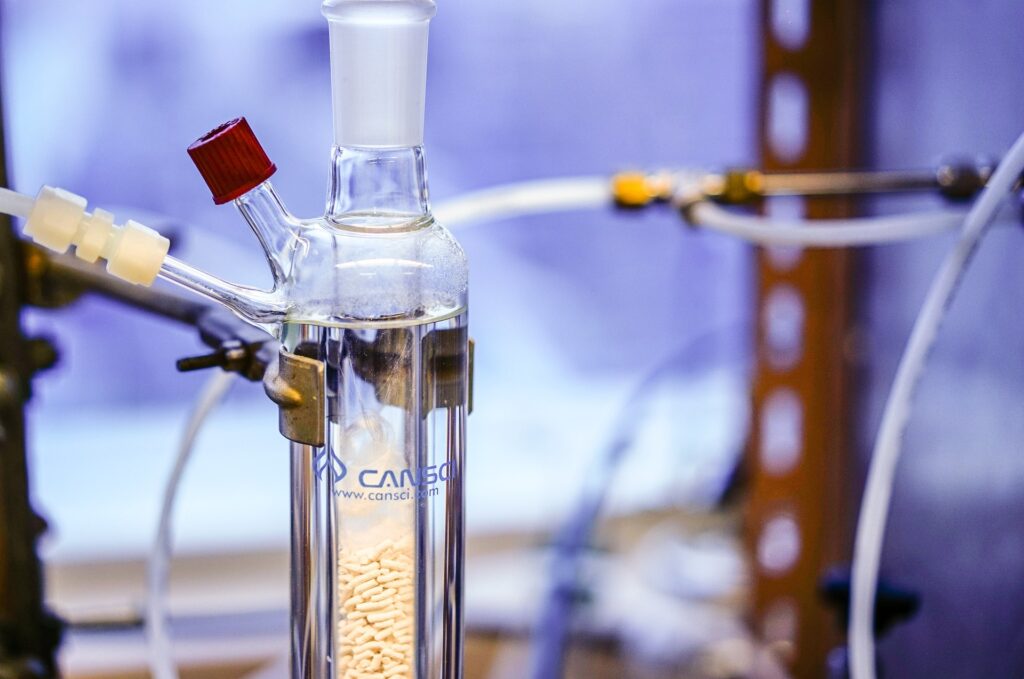Allelopathy is a biological phenomenon in which one plant produces biochemicals that affect the growth, survival, or reproduction of other plants. Some plants can have a positive allelopathic effect on others, helping to improve their growth or health, while others can have a negative effect, inhibiting or even killing nearby plants. Here are some examples of plants that are often cultivated together for allelopathic benefits:
- Sunflowers and beans: Sunflowers are known to produce chemicals that can inhibit the growth of certain weeds, while beans can fix nitrogen in the soil, which helps sunflowers to grow better.
- Tomatoes and basil: Basil is believed to produce chemicals that can help to repel pests that might attack tomatoes, while tomatoes can provide some shade for basil and help to retain moisture in the soil.
- Marigolds and vegetables: Marigolds are often planted in vegetable gardens because they are believed to produce chemicals that can help to repel certain pests, such as nematodes and whiteflies.
- Clover and grass: Clover is a legume that can fix nitrogen in the soil, which can benefit nearby grasses by providing them with a source of nitrogen.
- Black walnut trees and daffodils: Black walnut trees produce a chemical called juglone that can be toxic to many other plants, but daffodils are believed to be able to tolerate juglone and can even help to break it down in the soil, making it less toxic for other plants.
Here is a list of plants that exert allelopathy.
- Ailanthus (Tree-Of-Heaven)
- Aster
- Barley
- Bearberry
- Brassicas (All to varying degrees)
- Buckwheat
- Canada Thistle
- Cedar
- Corn (specifically corn gluten)
- Cucumber
- Dog Fennel
- Elderberry
- Eucalyptus
- English Laurel
- Ferns
- Foxtail (Yellow and Giant)
- Forsythia
- French-type Marigold
- Garlic mustard weed
- Goldenrod
- Johnsongrass
- Juniper
- Kentucky Bluegrass
- Nutsedge
- Oats
- Oregano
- Rye
- Rosemary
- Quackgrass
- Ragweed
- Rhododendron
- Sorghum
- Sugar Maple
- Sumac
- Sunflower
- Tall Fescue
- Walnut
- Wheat
Allelochemicals are naturally occurring compounds that are produced by plants and released into the environment, where they can influence the growth, development, and behavior of other organisms. In other words, allelochemicals are naturally occurring compounds that are produced by plants and released into the environment, where they can influence the growth, development, and behavior of other organisms.
Positive Effects of Allelochemicals: Allelochemicals can have positive effects on plants, including increasing their resistance to pests and diseases, improving nutrient uptake, and promoting growth and development. For example, allelochemicals produced by some legume plants can increase the availability of nitrogen in the soil, benefiting the growth of other nearby plants.
Negative Effects of Allelochemicals: On the other hand, allelochemicals can also have negative effects on plants, including inhibiting their growth and development, reducing crop yield, and even causing the death of nearby plants. For example, juglone produced by black walnut trees can inhibit the growth of many nearby plant species, including tomatoes, potatoes, and apples.

Some examples of allelochemicals include:
- Phenolic acids: These are a type of organic acid found in many plants, and they have been shown to inhibit the growth of other plants by interfering with their metabolic processes.
- Terpenoids: These are a diverse class of compounds that are found in many plants, and they have been shown to have various allelopathic effects, such as inhibiting seed germination, root growth, and photosynthesis.
- Alkaloids: These are nitrogen-containing compounds found in many plants, and they have been shown to have a wide range of biological activities, including allelopathy. For example, some alkaloids have been shown to inhibit the growth of other plants by interfering with their DNA synthesis.
- Fatty acids: These are a type of lipid that is found in many plants, and they have been shown to have allelopathic effects on other plants. For example, some fatty acids have been shown to inhibit seed germination and root growth.
- Flavonoids: These are a class of compounds found in many plants that are known for their antioxidant and anti-inflammatory properties. Some flavonoids have also been shown to have allelopathic effects on other plants by inhibiting their growth and development.
Here is a table that provides some examples of different classes of allelochemicals, along with the plants that produce them:
| Class of allelochemicals | Examples of allelochemicals | Plants producing them |
| Phenolic acids | Caffeic acid, ferulic acid | Wheat, rice, oats |
| Terpenoids | Pinene, limonene, menthol | Eucalyptus, pine, mint |
| Alkaloids | Nicotine, quinine, caffeine | Tobacco, cinchona, coffee |
| Fatty acids | Linoleic acid, oleic acid | Sunflower, soybean, flax |
| Flavonoids | Quercetin, kaempferol, naringenin | Onion, apple, tea |
Here are the structures of these chemicals.

Allelochemicals can be released by plants in several ways:
- Through root exudates: Plants can release allelochemicals into the soil through their roots. These chemicals can then inhibit the growth of neighboring plants or affect soil microorganisms.
- Through volatilization: Some plants can release allelochemicals into the air through volatile compounds, such as terpenes. These airborne allelochemicals can affect the growth and development of nearby plants.
- Through decomposition: When plants die and decompose, their allelochemicals can be released into the soil. This can create a “fallow allelopathy” effect where the allelopathic chemicals persist in the soil even after the plant is removed.
- Through foliar leaching: Some plants can release allelochemicals into the soil through leaching from their foliage. This can occur through rainwater or irrigation.


Intercropping and cover cropping are two agricultural practices that take advantage of allelopathy to improve crop yield and reduce the use of synthetic fertilizers and herbicides.
Intercropping involves planting two or more different crops in the same field simultaneously, usually in a specific pattern or arrangement. The crops used in intercropping are usually selected based on their complementary growth patterns, nutrient requirements, and allelopathic effects. For example, legume plants like soybean and pea can be intercropped with cereals like corn and wheat. Legumes are known to fix nitrogen in the soil, making it available to nearby plants, while cereals provide structural support for the legumes. Legumes also produce allelochemicals that inhibit the growth of nearby weeds, reducing competition for nutrients and water.
Cover cropping involves planting a crop solely to improve soil health and fertility, rather than for harvesting. The cover crop is usually planted after the main crop has been harvested, and its primary function is to provide ground cover, prevent soil erosion, and add organic matter to the soil. Cover crops are often selected based on their ability to fix nitrogen in the soil, suppress weeds, and produce allelochemicals that inhibit the growth of soil-borne pathogens. For example, rye grass and clover are commonly used as cover crops because they produce allelochemicals that suppress the growth of soil-borne pathogens like Fusarium and Rhizoctonia.
The practice of planting marigold plants between tomato plants is based on the allelopathic effects of marigold plants, specifically their ability to produce allelochemicals that repel or inhibit the growth of nematodes and other soil-borne pests. Marigold plants are known to produce a variety of allelochemicals, including thiophenes, terpenoids, and flavonoids, that can affect the growth and survival of neighboring plants and pests. Some of these allelochemicals have been shown to have nematicidal properties, meaning they can kill or repel nematodes, which are common pests that can damage tomato plants and reduce crop yield. When marigold plants are planted between tomato plants, the allelochemicals they produce can leach into the soil and create a hostile environment for nematodes and other pests. This can help protect the tomato plants from nematode damage and promote healthy growth and yield. In addition to their allelopathic effects, marigold plants are also known to attract beneficial insects like ladybugs and lacewings, which can help control other pests that may be harmful to tomato plants. This makes marigold plants a valuable companion plant for tomatoes and a natural, eco-friendly alternative to synthetic pesticides and herbicides.
Also, coriander (Coriandrum sativum) is another plant that can produce allelochemicals that have been shown to repel or inhibit the growth of some common pests, including aphids, spider mites, and whiteflies. Some studies have suggested that intercropping coriander with other crops like tomato, cucumber, and cabbage can help repel these pests and reduce the need for synthetic pesticides. For example, a study conducted in India found that intercropping coriander with tomato plants resulted in significantly fewer whitefly infestations compared to tomato plants grown alone. The allelochemicals produced by coriander that are believed to have insecticidal properties include linalool, alpha-pinene, and alpha-terpinene, which are found in the plant’s essential oils. These compounds are thought to affect the behavior and physiology of insects, making them less likely to feed or reproduce on nearby plants.
In summary, allelopathy is a natural phenomenon where one plant produces biochemicals that exert an influence over other plants. These biochemicals are known as allelochemicals and can have both beneficial or detrimental effects on neighboring plants, animals, insects, and organisms. Allelopathy can inhibit germination and or growth of other plant species. They serve as weed killers, but on the flip side they will also inhibit the development and growth of other garden crops. Allelopathy is heavily incorporated into the science of Companion Planting. The use of allelopathy in agriculture can be a sustainable and eco-friendly way to control weeds and pests, reduce the use of synthetic herbicides and insecticides, and improve soil health. Intercropping and cover cropping are common practices that utilize allelopathy to improve crop yields and soil fertility. Overall, allelopathy is a complex and fascinating natural phenomenon that has both positive and negative effects on neighboring plants and organisms. With proper understanding and management, allelopathy can be harnessed for sustainable and effective agricultural practices.



